Load Distribution of Semi-Central Evaporative Cooling Air-Conditioning System Based on the TRNSYS Platform
Abstract
:1. Introduction
2. Methods
2.1. The Layout of Evaporative Cooling Air-Conditioning System
2.2. The Mode of Evaporative Cooling Air-Conditioning System
2.3. The control Strategy of Evaporative Cooling Air-Conditioning System
- (1)
- When the summer outdoor air state point W was in area I, that is hw < ho, dw < do, the evaporative cooling air-conditioning unit opened the direct evaporative cooling section to process the outdoor air. The enthalpy-humidity chart with air process and the process diagram are shown in Figure 4a.
- (2)
- When the summer outdoor air state point W was in area II, that is hw > ho, dw ≤ do, the evaporative cooling air-conditioning unit opened the indirect evaporative cooling section and the direct evaporative cooling section to process the outdoor air. The enthalpy-humidity chart with air process and the process diagram are shown in Figure 4b.
- (3)
- When the summer outdoor air state point W was in areas III~V, the direct evaporative cooling was unable to meet the indoor air requirements. At this time, the indirect evaporative cooling section was opened to precool the outdoor air, and opened the surface cooling section of evaporative cooling air-conditioning unit to cool and dehumidify outdoor air. The enthalpy-humidity chart with air process and the process diagram are shown in Figure 4c.
2.4. The Case Study for Evaporative Cooling Air-Conditioning System
- (1)
- Determination of the air supply state point Oi:
- (2)
- Determination of the fresh air process state point: Li:
- (a)
- When the outdoor state point was in area I, the enthalpy-humidity chart of the air process, which was direct evaporative cooling, is shown in Figure 4a, then hLi = hWi.
- (b)
- When the outdoor state point was in area II, the enthalpy-humidity chart of the air process, which was indirect and direct evaporative cooling, is shown in Figure 4b. It was found that the indirect evaporative cooling efficiency was 75% by calculation and consultations with the equipment manufacturers, then dwIi = dwi. The enthalpy, which was hwIi of the indirect process state point WIi, was output by the TRNSYS psychrometer program, then hLi = hWIi.
- (c)
- When the outdoor state point was in areas III~V, the enthalpy-humidity chart of the air process, which was indirect evaporative cooling and mechanical refrigeration, was shown in Figure 4c.
Saturation partial pressure PsLi of the fresh air process state point Li:Dry bulb temperature ti of the fresh air process state point Li:hLi was output by the TRNSYS psychrometer program according to the dry bulb temperature and moisture content. - (3)
- Determination of the fan-coil unit process state point Mi:
- (4)
- Determination of the indirect process point WIi of the fresh air unit:
- (a)
- When the outdoor state point was in area II: the determination process of state point WIi is as shown in the second method in Section 2.4 (2).
- (b)
- When the outdoor state point was in the areas III~V, the enthalpy-humidity chart of the air process, which was indirect evaporative cooling and mechanical refrigeration, is as shown in Figure 4c. The indirect evaporative cooling efficiency was 75%, then twIi = twi − 0.75(twi − twsi), dwIi = dN. The enthalpy, which was the hwIi of the indirect process point WIi, was output by the TRNSYS psychrometer program.
- (5)
- Determining the operation strategy of evaporative cooling unit by TRNSYS according to each state point. At the same time, the loads which were provided by the direct evaporative cooling section, the indirect evaporative cooling section, the surface cooling section and the fan-coil unit, was respectively output.
- (a)
- When the outdoor state point was in area I: the loads provided by the direct evaporation section:The loads provided by fan-coil unit:
- (b)
- When the outdoor state point was in area II: the loads provided by the indirect evaporation section:The loads provided by the direct evaporation section:The loads provided by fan-coil unit:
- (c)
- When the outdoor state point was in areas III~V: the loads provided by the indirect evaporation section:The loads provided by the surface cooling section:The loads provided by fan-coil unit:
3. Results and Discussion
3.1. Applicability Judgment of Evaporative Cooling Air-Conditioning Unit
3.2. Analysis of Load Distribution of Evaporative Cooling Air-Conditioning System
- (1)
- When the outdoor state point was in area I, outdoor fresh air was processed by opening the direct section of evaporative cooling air-conditioning unit. At the same time, the fan-coil unit handled the indoor return air. The cumulative loads provided by direct evaporative cooling section were 20,023.69 kWh, and the cumulative loads provided by fan-coil unit were 20,023.69 kWh. The loads provided by the evaporative cooling air-conditioning unit accounted for 18.65% of the total loads.
- (2)
- When the outdoor state point was in area II, the outdoor fresh air was processed by opening the direct and indirect section of the evaporative cooling air-conditioning unit. The cumulative loads of indirect and direct evaporative cooling section were respectively 3347.36 kWh, 75.96 kWh. The loads provided by the evaporative cooling air-conditioning unit accounted for 3.19% of the total loads.
- (3)
- When the outdoor state point was in areas III~V, the requirements of air supply could not be achieved by opening the indirect and direct evaporative cooling unit. Therefore, the indirect section and surface cooling section of air-conditioning unit needed to be opened to process fresh air. The cumulative loads provided by indirect evaporative cooling section were 3883.92 kWh and accounted for 3.62% of the total loads.
- (4)
- In summer, when the outdoor meteorological parameters change hourly, the loads provided by the direct and indirect evaporative cooling sections accounted for 25.46% of the total loads in different regions.
4. Conclusions
- (1)
- In summer, outdoor fresh air can be processed by evaporative cooling in Lanzhou, and the guaranteed rate of evaporative cooling air-conditioning is 89.51%.
- (2)
- The loads provided by the direct evaporative cooling and indirect evaporative cooling account for 25.46% of the total loads in an office building located in Lanzhou, which is of great significance to reduce the energy consumption of air-conditioning systems.
- (3)
- In the five regions divided according to the outdoor meteorological parameters in Lanzhou, the outdoor dry bulb temperature is higher, the relative humidity is smaller, and air-conditioning units can provide greater cooling loads. Therefore, the system can produce more obvious energy-saving effects.
- (4)
- According to the hot and dry climate characteristics in Lanzhou in summer, temperature and humidity independent control principle is applied to an evaporative cooling air-conditioning system, which achieves a better energy saving effect. As a result, the air-conditioning system is suitable for application in northwest China. In addition, it should also be suitable for other areas where the climate is relatively hot and dry.
Author Contributions
Acknowledgments
Conflicts of Interest
Nomenclature
| dp | ideal air supply moisture content, g/kg |
| hW | outdoor air enthalpy, kJ/kg |
| L | direct evaporative cooling state point |
| M | constant humidify cooling state point |
| ε | heat humidity ratio, kJ/kg |
| ϕ | relative humidity, % |
| hoi | hourly air enthalpy, kJ/kg |
| do | hourly air supply moisture content, g/kg |
| dLi | hourly fresh air moisture content, g/kg |
| hLi | hourly fresh air enthalpy, kJ/kg |
| dwli | hourly fresh air moisture content, g/kg |
| dWi | hourly outdoor air moisture content, g/kg |
| twsi | hourly indirect evaporative cooling temperature, °C |
| cp | heat capacity at constant pressure, kJ/(kg·°C) |
| hMi | constant humidify cooling state point enthalpy, kJ/kg |
| tL | direct evaporative cooling state point temperature, °C |
| tM | constant humidify cooling state point temperature, °C |
| ho | ideal air supply enthalpy, kJ/kg |
| twli | hourly fresh air temperature, °C |
| tW | outdoor air temperature, °C |
| tw | hourly outdoor air temperature °C |
| Wi | hour outdoor air condition point |
| hwl | outdoor fresh air enthalpy, kJ/kg |
| twl | outdoor fresh air temperature, °C |
| hWi | hourly outdoor air enthalpy, kJ/kg |
| O | the ideal air supply state point |
| N | the indoor design air state point |
| tO | ideal air supply temperature |
| tW | outdoor air temperature |
References
- Vakiloroaya, V.; Samali, B.; Fakhar, A.; Kambiz, P. A review of different strategies for HVAC energy saving. Energy Convers. Manag. 2014, 77, 738–754. [Google Scholar] [CrossRef]
- Liu, Z.; Cheng, K.; Li, H.; Geo, G.; Wu, D.; Shi, Y. Exploring the potential relationship between indoor air quality and the concentration of airborne culturable fungi: A combined experimental and neural network modeling study. Environ. Sci. Pollut. Res. 2018, 25, 3510–3517. [Google Scholar] [CrossRef] [PubMed]
- Liu, Z.; Xu, W.; Zhai, X.; Qian, C.; Chen, X. Feasibility and performance study of the hybrid ground-source heat pump system for one office building in Chinese heating dominated areas. Renew. Energy 2017, 101, 1131–1140. [Google Scholar] [CrossRef]
- Liu, Z.; Xu, W.; Qian, C.; Jin, G. Investigation on the feasibility and performance of ground source heat pump (GSHP) in three cities in cold climate zone, China. Renew. Energy 2015, 84, 89–96. [Google Scholar] [CrossRef]
- Pérez-Lombard, L.; Ortiz, J.; Pout, C. A review on buildings energy consumption information. Energy Build. 2008, 40, 394–398. [Google Scholar] [CrossRef]
- Li, H.; Liu, Z.; Liu, K.; Zhang, Z. Predictive power of machine learning for optimizing solar water heater performance: the potential application of high-throughput screening. Int. J. Photoenergy 2017, 2017, 4194251. [Google Scholar] [CrossRef]
- Ghaddar, N.; Ghali, K.; Najm, A. Use of desiccant dehumidification to improve energy utilization in air-conditioning systems in Beirut. Int. J. Energy Res. 2003, 27, 1317–1338. [Google Scholar] [CrossRef]
- Zhang, T.; Liu, X.; Jiang, Y. Development of temperature and humidity independent control (THIC) air-conditioning systems in China—A review. Renew. Sustain. Energy Rev. 2014, 29, 793–803. [Google Scholar] [CrossRef]
- Wang, R.Z.; Yu, X.; Ge, T.S.; Li, T.X. The present and future of residential refrigeration, power generation and energy storage. Appl. Therm. Eng. 2013, 53, 256–270. [Google Scholar] [CrossRef]
- Niu, J.L.; Zhang, L.Z.; Zuo, H.G. Energy savings potential of chilled-ceiling combined with desiccant cooling in hot and humid climates. Energy Build. 2002, 34, 487–495. [Google Scholar] [CrossRef]
- Liu, Z.; Li, H.; Liu, K.; Yu, H.; Cheng, K. Design of high-performance water-in-glass evacuated tube solar water heaters by a high-throughput screening based on machine learning: A combined modeling and experimental study. Sol. Energy 2017, 142, 61–67. [Google Scholar] [CrossRef]
- Liu, X.H.; Jiang, Y. Temperature and Humidity Independent Control Air-Conditioning System; China Archit. Build. Press: Beijing, China, 2006; ISBN 9787112078400. (In Chinese) [Google Scholar]
- Li, X. Analysis on the Utilization of Temperature and Humidity Independent Control Air-conditioning System with Different Fresh-air Handling Methods. Procedia Eng. 2017, 205, 71–78. [Google Scholar] [CrossRef]
- Tiezhu, S.; Xiang, H.; Li, W. Discussion of water-system ratio of evaporative cooling and mechanical refrigeration compound high-temperature chiller. Fluid Mach. 2011, 39, 81. (In Chinese) [Google Scholar]
- Huang, X.; Qiang, T.; Wu, J.; Di, Y. Study on automatic control scheme of evaporative-cooling air-conditioning system. J. HV AC 2003, 33, 109–112. (In Chinese) [Google Scholar]
- Liu, X.; Huang, X.; Yao, D.; Wu, Z.; Wang, C. The Comparison and Analysis between Evaporative Cooling Combined System and Traditional Central and Semi-central Air-conditioning System in Middle-humidity Areas. Refrigeration 2009, 28, 63–68. (In Chinese) [Google Scholar]
- Chen, Y.; Yang, H.; Luo, Y. Investigation on solar assisted liquid desiccant dehumidifier and evaporative cooling system for fresh air treatment. Energy 2018, 143, 114–127. [Google Scholar] [CrossRef]
- Jiang, Y.; Ge, T.S.; Wang, R.Z.; Huang, Y. Experimental investigation on a novel temperature and humidity independent control air-conditioning system—Part I: Cooling condition. Appl. Therm. Eng. 2014, 73, 784–793. [Google Scholar] [CrossRef]
- Zhao, K.; Liu, X.H.; Zhang, T.; Jiang, Y. Performance of temperature and humidity independent control air-conditioning system in an office building. Energy Build. 2011, 43, 1895–1903. [Google Scholar] [CrossRef]
- Xuan, Y.M.; Xiao, F.; Niu, X.F.; Huang, X.; Wang, S.W. Research and application of evaporative cooling in China: A review (I)—Research. Renew. Sustain. Energy Rev. 2012, 16, 3535–3546. [Google Scholar] [CrossRef]
- Han, Z.; Zhang, Y.; Meng, X.; Liu, Q.; Li, W.; Han, Y.; Zhang, Y. Simulation study on the operating characteristics of the heat pipe for combined evaporative cooling of computer room air-conditioning system. Energy 2016, 98, 15–25. [Google Scholar] [CrossRef]
- Goetzler, W.; Zogg, R.; Young, J.; Johnson, C. Energy Savings Potential and RD&D Opportunities for Non-Vapor-Compression HVAC Technologies; Prepared for U.S. Department of Energy; Navigant Consulting, Inc.: Burlington, MA, USA, 2014. [Google Scholar]
- Lowenstein, A. Review of liquid desiccant technology for HVAC applications. Hvac R Res. 2008, 14, 819–839. [Google Scholar] [CrossRef]
- Mohammad, A.T.; Mat, S.B.; Sulaiman, M.Y.; Sopian, K.; Al-abidi, A. Survey of hybrid liquid desiccant air-conditioning systems. Renew. Sustain. Energy Rev. 2013, 20, 186–200. [Google Scholar] [CrossRef]
- Liu, Z.; Wu, D.; Yu, H.; Wensheng, M.; Guangya, J. Field measurement and numerical simulation of combined solar heating operation modes for domestic buildings based on the Qinghai-Tibetan plateau case. Energy Build. 2018, 167, 312–321. [Google Scholar] [CrossRef]
- Dan, Z.; Xiang, H.; Jiang, L.; Aoshuang, D. The study of the design principles and steps of evaporative cooling air-conditioning system. Refrig. Air Cond. 2008, 4, 18–24. (In Chinese) [Google Scholar]
- Technical Specification for Evaporative Cooling Refrigeration System JGJ342-2014; Uniform Book Number: 15112·23994; China Architecture & Building Press: Beijing, China, 2015. (In Chinese)
- National Technical Measures for Design of Civil Construction-Heating, Ventilation and Air-Conditioning; China Planning Press: Beijing, China, 2009; ISBN 978-7-80242-470-8. (In Chinese)
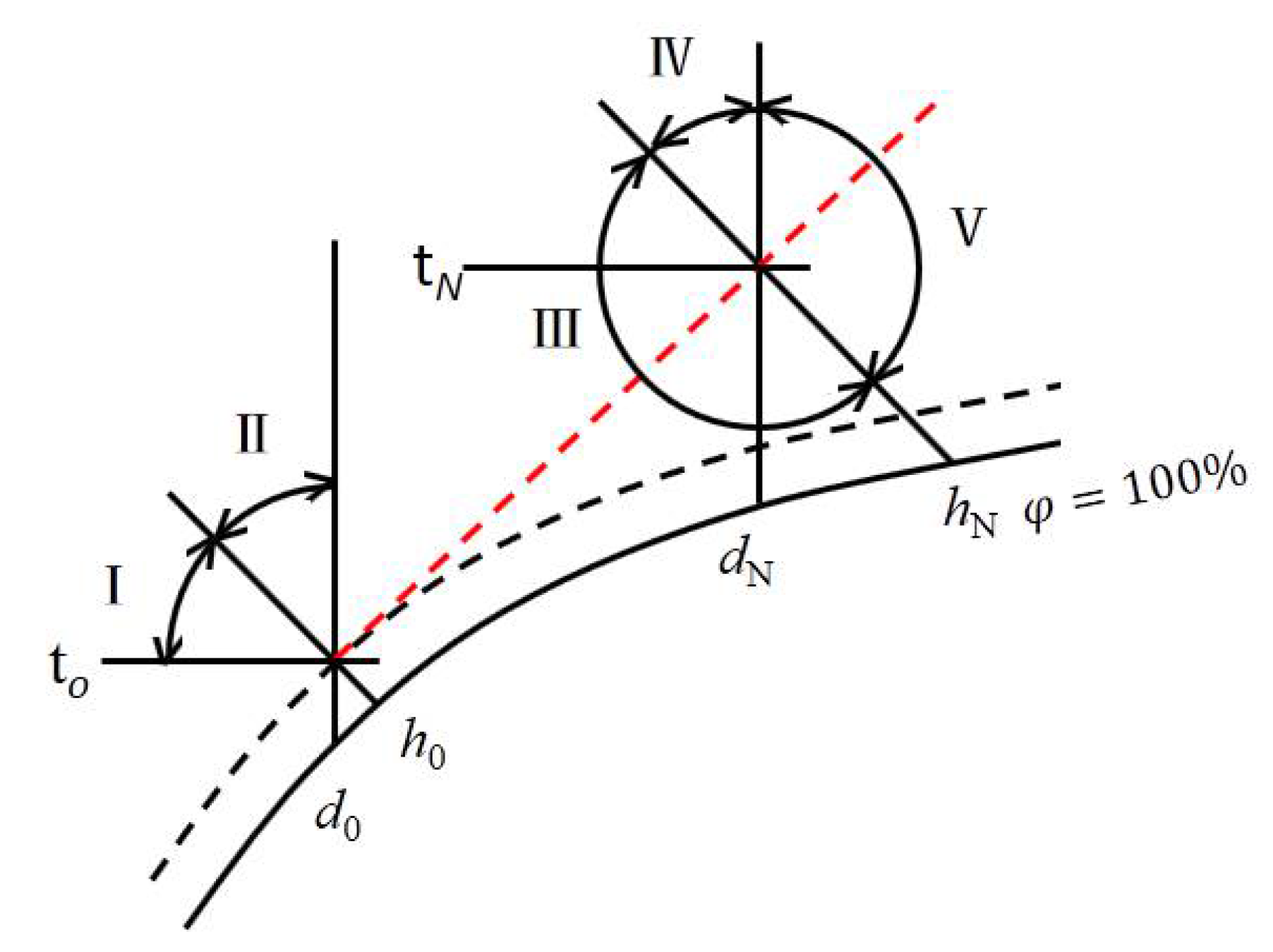

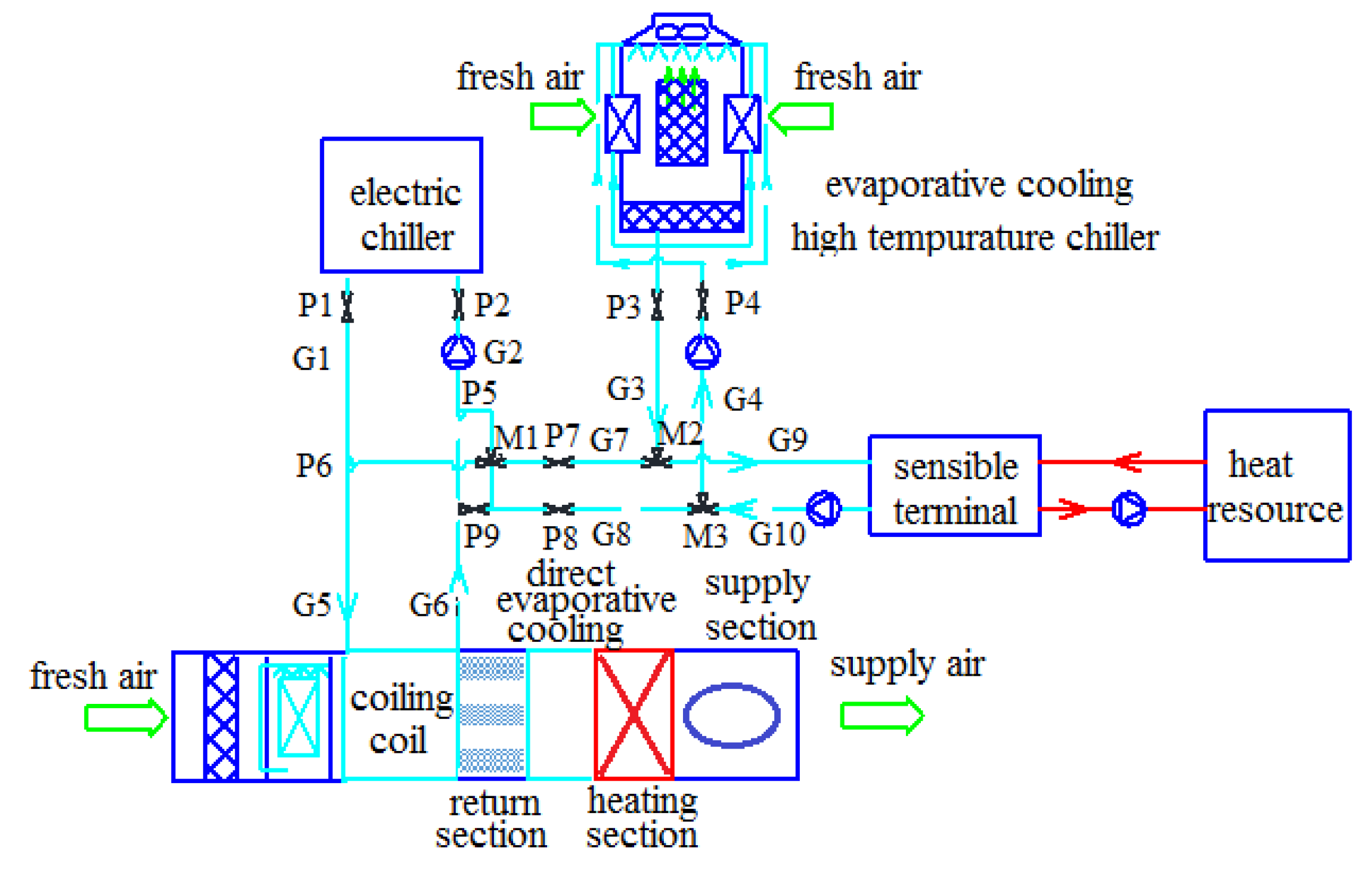
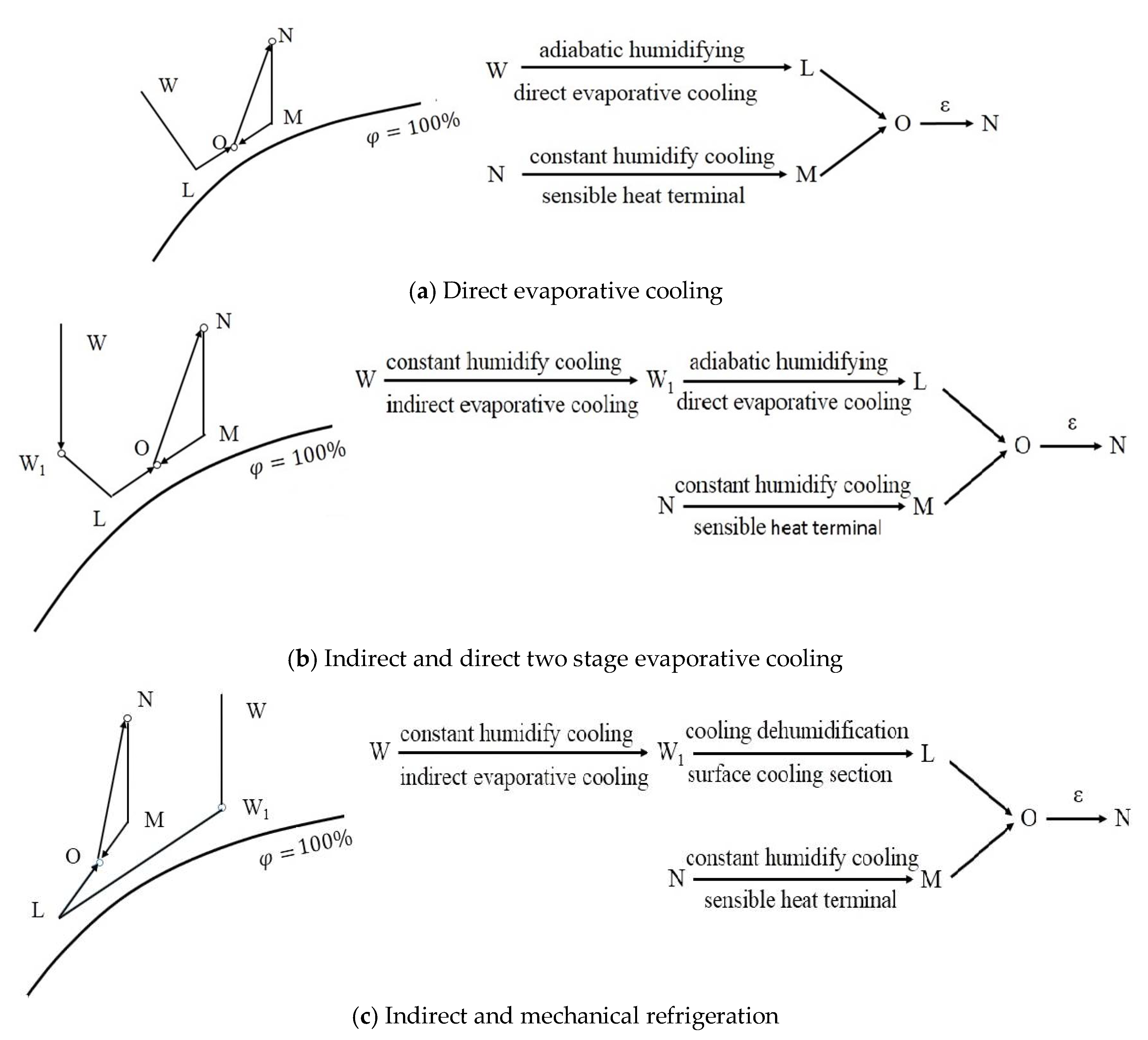
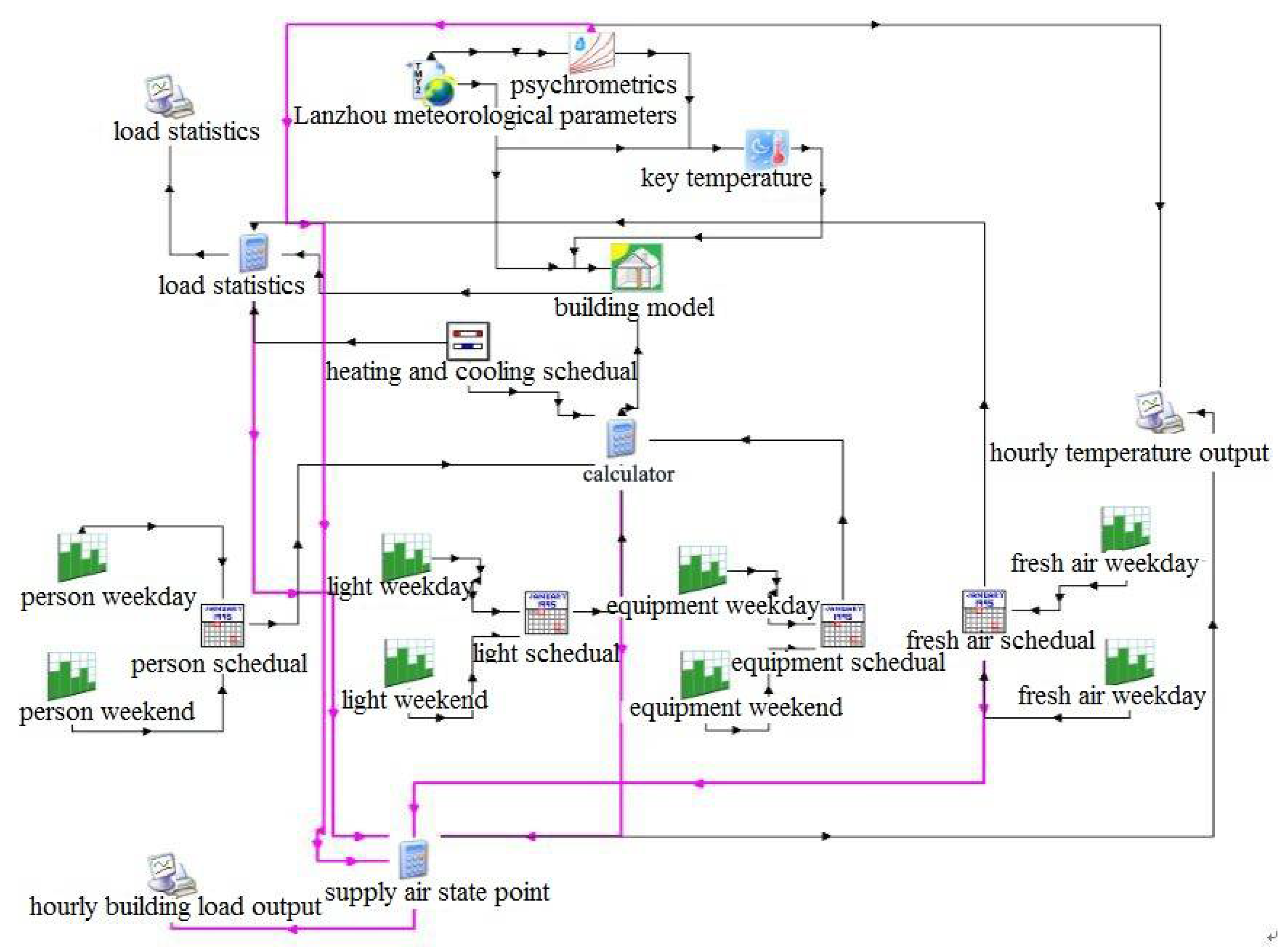
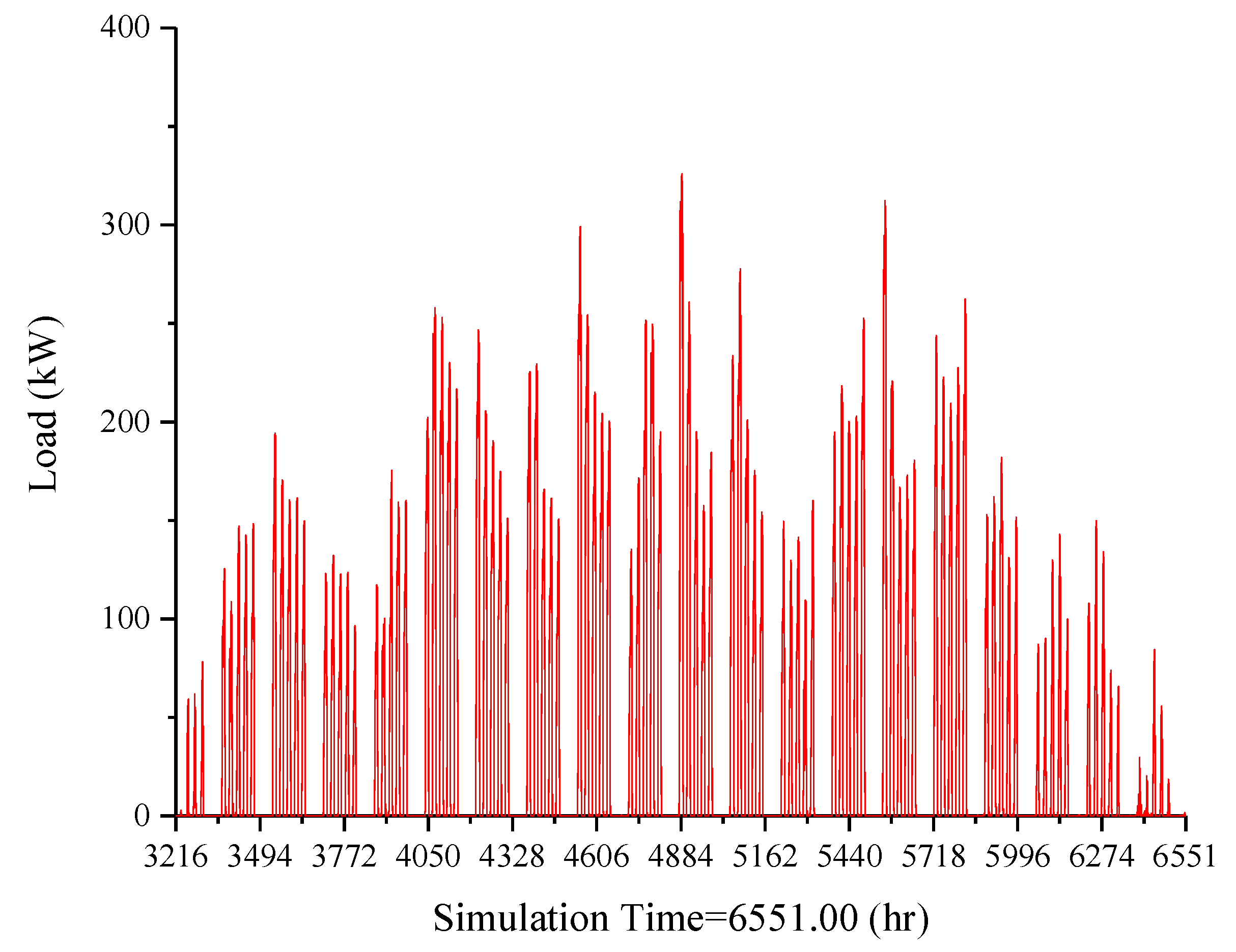
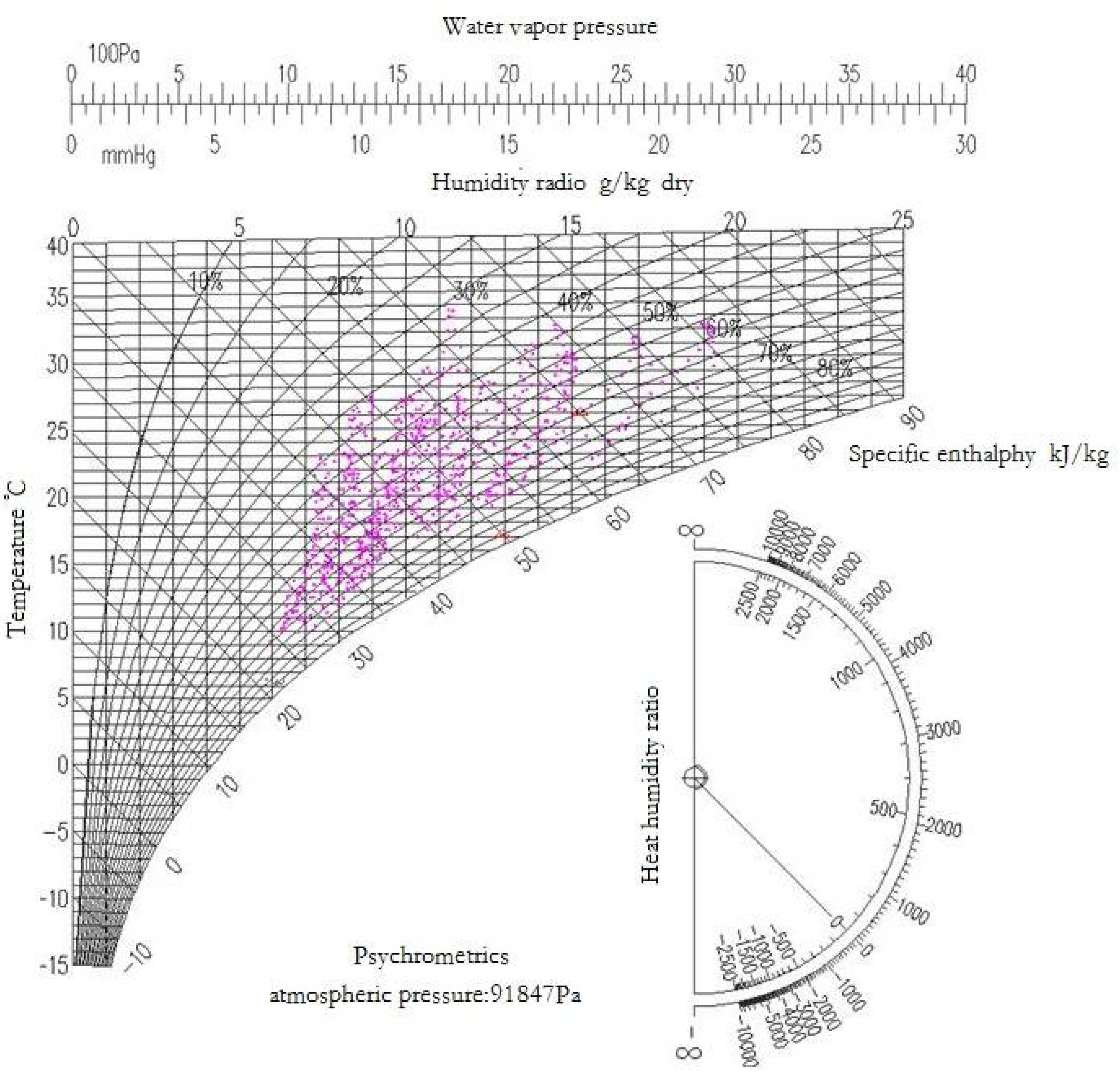
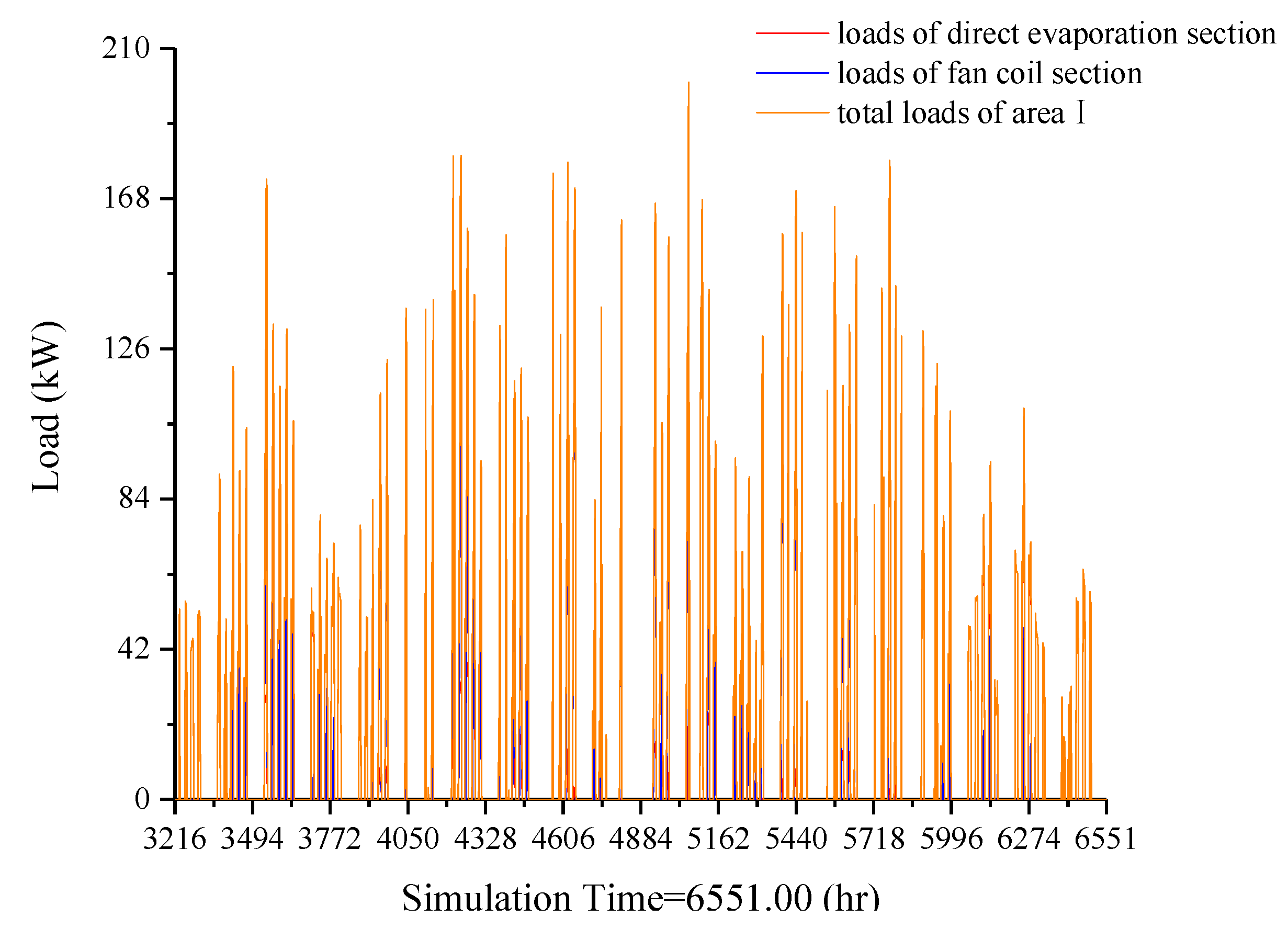
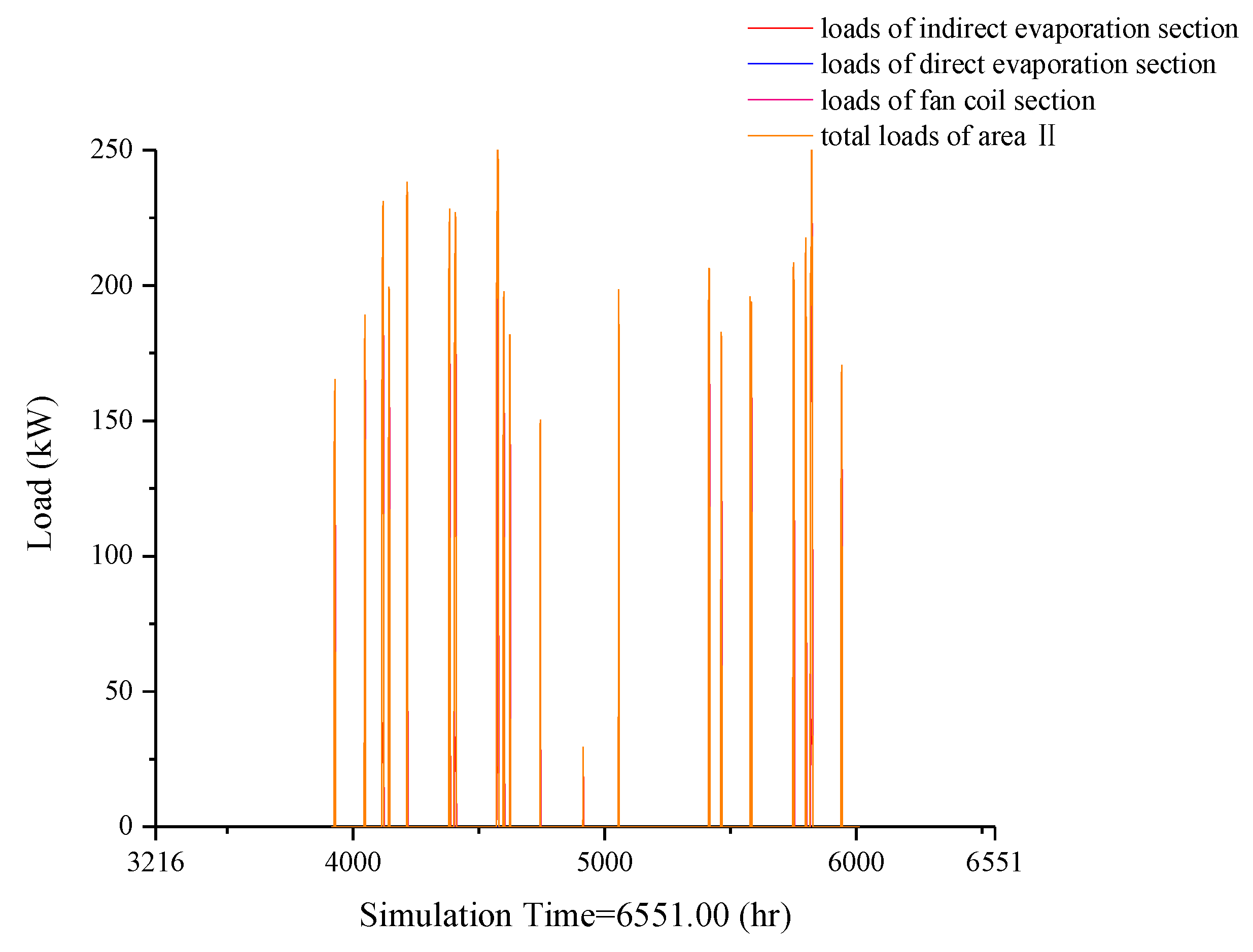
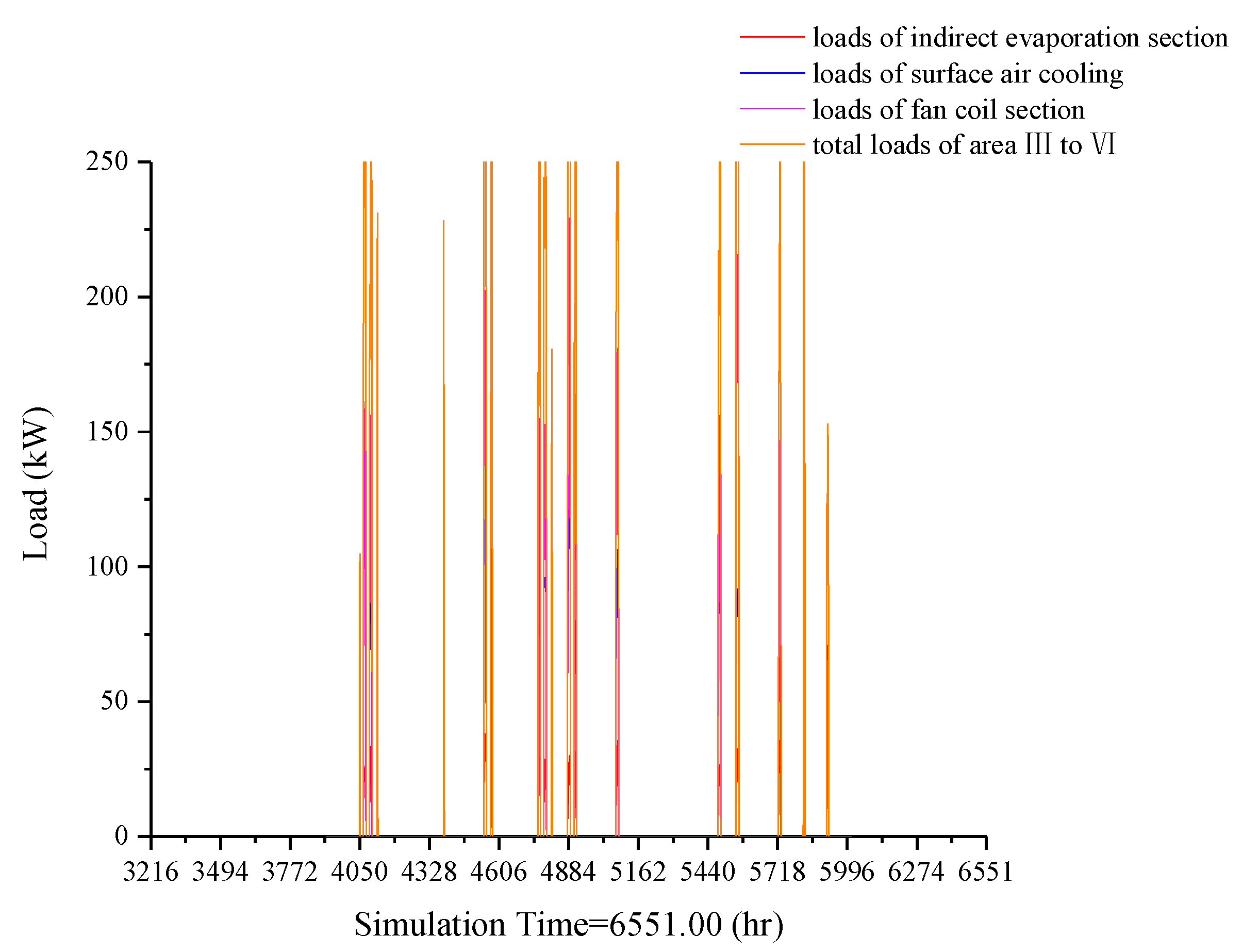
| Number | 1 | 2 | 3 | 4 | 5 | 6 | 7 | 8 |
|---|---|---|---|---|---|---|---|---|
| Equipment | Fresh air unit (Evaporative cooling combined air-conditioning unit) | Cold source | Terminal | |||||
| Function section | Coarse filtration section | Indirect evaporative cooling section | Surface cooling section | Direct evaporative cooling section | Heating section | Cooling tower (Evaporative chiller) | Mechanical refrigeration chiller | Sensible heat terminal |
| i | √ | √ | √ | √ | ||||
| ii | √ | √ | √ | √ | ||||
| iii | √ | √ | √ | √ | √ | |||
| iv | √ | √ | √ | √ | √ | |||
| v | √ | √ | √ | √ | √ | |||
| vi | √ | √ | √ | √ | √ | √ | ||
| vii | √ | √ | √ | √ | √ | |||
| viii | √ | √ | √ | √ | √ | |||
| ix | √ | √ | √ | √ | √ | √ | ||
| Structural Layer | Thickness (mm) | Thermal Conductivity (W/(m·K)) | Specific Heat Capacity (kJ/(kg·K)) | Density (kg/m³) | Heat Transfer Coefficient (W/(m2·K)) | |
|---|---|---|---|---|---|---|
| Floor | Cement Mortar | 20 | 0.93 | 1.05 | 1800 | 0.6 |
| Extruded Polystyrene Board | 50 | 0.036 | 1.38 | 30 | ||
| Reinforced Concrete | 150 | 1.74 | 0.92 | 2500 | ||
| Exterior Wall | Expanded Polystyrene Board | 50 | 0.05 | 1.38 | 30 | 0.6 |
| Light Aggregate Concrete | 190 | 0.29 | 1.05 | 500 | ||
| Lime Mortar | 15 | 0.81 | 1.05 | 1600 | ||
| Roof | Extruded polystyrene Board | 50 | 0.036 | 1.38 | 30 | 0.55 |
| Light Aggregate Concrete | 30 | 0.29 | 1.05 | 500 | ||
| Cement Mortar | 15 | 0.93 | 1.05 | 1800 | ||
| Reinforced Concrete | 250 | 1.74 | 0.92 | 2500 |
| Classification | Outdoor State Point | Indoor State Point | Air Supply State Point |
|---|---|---|---|
| Dry Bulb Temperature °C | 31.2 | 26 | 18.05 |
| Wet Bulb Temperature °C | 20.1 | 20.33 | 17.67 |
| Relative Humidity % | 36% | 60% | 95% |
| Moisture content g/kg (Dry air) | 10.16 | 12.64 | 12.48 |
| Enthalpy kJ/kg | 57.37 | 58.20 | 49.80 |
| Partition | I | II | III | IV | V |
|---|---|---|---|---|---|
| Hours h | 2640 | 346 | 100 | 41 | 244 |
| Percentage of Air-conditioning Hours % | 79.14 | 10.37 | 3.00 | 1.23 | 7.31 |
| Partition | Peak Loads kW | Cumulative Loads kWh | ||
|---|---|---|---|---|
| Area I Direct Evaporation Section | Direct Evaporation Section | 69.72 | Cumulative Direct Evaporation Section | 20,023.69 |
| Fan Coil | 200.57 | Cumulative Fan Coil | 34,521.43 | |
| Area II Direct and Indirect Evaporation Section | Indirect Evaporation Section | 50.24 | Cumulative Indirect Evaporation Section | 3347.36 |
| Direct Evaporation Section | 17.47 | Cumulative Direct Evaporation Section | 75.96 | |
| Fan Coil | 233.82 | Cumulative Fan Coil | 15,028.96 | |
| Area III IV V Indirect Evaporation Section and Surface Cooling Section | Indirect Evaporation Section | 39.94 | Cumulative Indirect Evaporation Section | 3883.92 |
| Surface Cooling Section | 125.79 | Cumulative Surface Cooling Section | 13,438.61 | |
| Fan Coil | 229.21 | Cumulative Fan Coil | 17,024.51 | |
| Total Value | 107,344.45 | |||
© 2018 by the authors. Licensee MDPI, Basel, Switzerland. This article is an open access article distributed under the terms and conditions of the Creative Commons Attribution (CC BY) license (http://creativecommons.org/licenses/by/4.0/).
Share and Cite
Li, J.; Liu, Y.; Zhang, R.; Liu, Z.; Xu, W.; Qiao, B.; Feng, X. Load Distribution of Semi-Central Evaporative Cooling Air-Conditioning System Based on the TRNSYS Platform. Energies 2018, 11, 1186. https://doi.org/10.3390/en11051186
Li J, Liu Y, Zhang R, Liu Z, Xu W, Qiao B, Feng X. Load Distribution of Semi-Central Evaporative Cooling Air-Conditioning System Based on the TRNSYS Platform. Energies. 2018; 11(5):1186. https://doi.org/10.3390/en11051186
Chicago/Turabian StyleLi, Ji, Yuanwei Liu, Ruixue Zhang, Zhijian Liu, Wei Xu, Biao Qiao, and Xiaomei Feng. 2018. "Load Distribution of Semi-Central Evaporative Cooling Air-Conditioning System Based on the TRNSYS Platform" Energies 11, no. 5: 1186. https://doi.org/10.3390/en11051186
APA StyleLi, J., Liu, Y., Zhang, R., Liu, Z., Xu, W., Qiao, B., & Feng, X. (2018). Load Distribution of Semi-Central Evaporative Cooling Air-Conditioning System Based on the TRNSYS Platform. Energies, 11(5), 1186. https://doi.org/10.3390/en11051186





